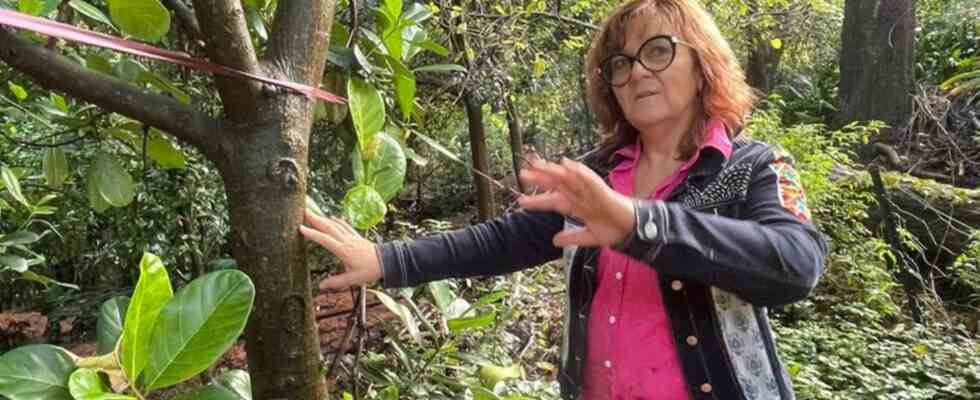The fear of war and Corona makes many people want to take care of themselves in an emergency. The “permaculture” developed in Australia can help here. The motto is to survive in harmony with nature.
Whoever visits April Sampson-Kelly immediately senses that something is different about this place. Wild, enchanted and somehow untouched. Giant trees grow in the front yard and an enormous bamboo that reaches into the sky.
In between there are smaller fig, lime and carob trees as well as coffee and ginger plants. In the distance, geese and chickens cackle and cluck. But there is a method to the supposed chaos on the property.
Sampson-Kelly’s urban “Silk Farm” in Mount Kembla, about a two-hour drive south of Sydney, was designed according to the principles of “permaculture” – an Australian concept that allows everyone to design their garden and their way of life in a sustainable and ethical way. Just a lawn in the front yard, that was yesterday, smiles the 55-year-old mother of two sons. She looks proudly at the lush flora all around. Around 200 types of plants are now growing on the 1,600 square meter farm, including bananas, guavas, mangoes, taros, sweet potatoes and various herbs. This means that the family can take care of itself almost completely.
«”Cool” form of organic gardening»
Feeding your household directly from the garden is one of the goals of permaculture. “Some call permaculture a “cool” form of organic gardening,” says David Holmgren, who co-founded the movement more than 40 years ago, in an interview with the German Press Agency. “It is a design system for sustainable and resilient land use and way of life.”
Together with the biologist Bill Mollison, the ecologist and environmental designer Holmgren published the book “Permaculture One” in 1978 – the term is made up of the words “permanent” and “agriculture”. The twelve principles explained in the handbook include practical ideas such as avoiding waste and using renewable energy, as well as mottos such as “Look for slow and small solutions”. The ultimate goal is to develop an agriculture that enables survival in harmony with nature.
Permaculture is being practiced in many different ways today, in both densely populated and rural areas, says Holmgren. “This ranges from wealthy, socially comfortable milieus to the poorest on the planet.” The principles are universal. Depending on the context and location – whether in the tropical north of Australia or in temperate Central Europe – the design is different.
“Less work than lawn – but you need more knowledge”
As wild as the Silk Farm in Mount Kembla looks, everything is carefully planned here. Plants that need a lot of water are supplied with recycled waste water, the high tree canopy offers shade, prickly plants at the edge of the property deter unwanted animals. “Observation is key,” says Sampson-Kelly. “A permaculture area is less work than a lawn that has to be mowed. But you need more knowledge, you have to observe and make decisions.”
Irish architect and permaculture designer Declan Kennedy brought the concept to Germany in the 1980s. Today it is even taught at universities. “Permaculture basically works worldwide,” says Christopher Henrichs, Chairman of the Permaculture Lower Rhine Association. “For me, it’s an exciting toolbox to help shape the future.”
“By the way” reduce greenhouse gas emissions
Interest in permaculture is steadily increasing worldwide. Because the fear of food shortages and the desire to be able to take care of yourself in an emergency have grown as a result of the war in Ukraine, the corona pandemic and the climate crisis. “In practice, permaculture means focusing on greater self-sufficiency and resilience – in climate change language we call it ‘adaptation’,” says co-founder Holmgren. “In this way, you automatically reduce greenhouse gas emissions – even if that wasn’t the actual motivation.”
Can permaculture be a solution in the fight against climate change – or are the ideas from Down Under only suitable for your own garden? “For us, the heart of the matter is to look: Does the whole thing work on a large scale and commercially and can that contribute to the urgently needed change?” says Henrichs. With educational work, the association wants to end the niche existence of permaculture in Germany and spread the ideas further.
Permaculture has hardly arrived at the political level, but it has with many citizens, says Florian Wichern, Professor of Sustainable Agriculture at the Rhine-Waal University of Applied Sciences. Her motivation: “Several people strive to support a better world. And the realization that the various ecological crises must also lead to a change in action.”
Holmgren: Global potential
For the Australian permaculture pioneer Holmgren, his principles have the potential to contribute to a change in thinking worldwide: “There are people who describe permaculture as a “revolution disguised as gardening”. However, it remains to be seen whether teaching can really bring about changes globally.
In the meantime, anyone can start the change small: “First we ask: How can we use energy and nutrients that are usually lost?” says Sampson-Kelly, who also offers permaculture workshops on her farm. An example is food leftovers in the kitchen. “It’s a source of nutrients that you can easily use for a worm farm.” The worms turn the food leftovers into compost for the garden – and so the circle closes.

